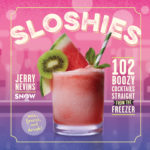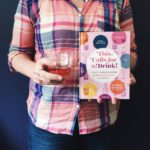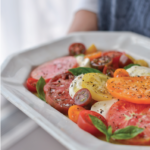Originally published in Publishers Weekly, this excerpt of the full interview sheds light on why authors David Solmonson and Lesley Jacons Solmonson chose the 12 bottles they did and give us a peek at the process.
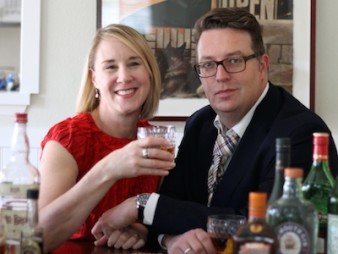
Out with the S’more Vodka, In with the Genever: PW Talks with David and Lesley Jacobs Solmonson
If the rise of cocktail culture has given us a spate of exciting drinking experiences—rare boozes, laboratorial techniques, fresh-squeezed this, and home-shaved that—it’s also, by the same token, left home bartenders in the dust. When every recipe calls for a thimbleful of some unpronounceable $60-per-bottle liqueur, the journey to cocktail expertise can seem like it’s over before it starts. That’s the feeling that David Solmonson, a former screenwriter, and his wife, Lesley Jacobs Solmonson, a wine and spirits writer, hoped to address when they launched their blog, 12BottleBar.com in 2009. Having experienced the frustrations of home bartending firsthand, they wanted to pare the process down to the basics: How many cocktails could you make using just 12 bottles without sacrificing flavor, technique, or creativity? The answer: enough to give your local molecular mixologist a run for his money. In The 12 Bottle Bar (Workman, Aug.), the Solmonsons serve up some 200 recipes using only a dozen bottles—“seven spirits, one liqueur, two vermouths, and two bitters”—while giving readers a fascinating tour of cocktail history. PW talked with the Solmonsons about the “golden age” of bartending, why they left tequila off their list, and writing as a couple.
Your project started as a website, 12BottleBar.com. What initially sparked your interest in writing about cocktails?
David Solmonson: We were certainly foodies, and all of our vacations were based around going to this hot restaurant or that hot restaurant. One of the things that started to appear in a lot of the “food science” restaurants was cocktails. And it was certainly, at home, a lot easier to make cocktails than to go out and buy a sous vide. And Lesley had just written her book on gin, which I’ll let her go into.
Lesley Jacobs Solmonson: [Gin: A Global History] was, I think, what opened all the doors in terms of the cocktail community. I was able to go up to people and say, Hi, you don’t know me, but I’m writing a gin book and I want some help, some information, some recipes, etc. That set us both on the path, especially with [12BottleBar.com], of getting to know people in the cocktail world. And they were instrumental for us in creating a flavor to the book, too.
A lot of the recipes in the book hark back to the “golden age” of cocktails, which you define as pre-Prohibition. Why were those drinks the best?
LJS: The golden age of cocktails is exactly what it sounds like. Everything was made fresh. You had to use fresh-squeezed citrus. You had to make your syrups by hand. You had to chip your own ice! Because that was the only way to do it. Of course, the result of that was exquisite product, which is something we lost in the modern era when everything became mechanized and bottled and canned.
In the book, you refer a lot to a 19th-century bartender named Jerry Thomas. Why was he such a big influence for you guys?
DS: Jerry Thomas is the Babe Ruth of bartenders. He is predominantly famous for having written the first real bartender’s manual [in 1862, Jerry Thomas’ Bartenders Guide]. It was the first example of, not only “here are the drinks that we’re drinking and here are the recipes,” but [also] lots of tactical applications: here’s how you sweeten gin, here’s how you make syrups, here’s how you use fresh fruit. It would be impossible to say “I’m gonna be in punk band” without looking at the Ramones and Sex Pistols. It’s hard to say to “I’m gonna be a classic bartender” without looking at Jerry Thomas.
One of your 12 bottles is genever, which you say is one of the oldest spirits known to man. I, for one, have never heard of it. What’s it like and why did you decide to include it?
LJS: Until I wrote the gin book, I had no idea what [genever] was. And the cocktail community really just started learning about it. It’s a proto-spirit. It started in the 1500s as a juniper-based tonic for health problems, and then it evolved into a malted beverage. It’s the great-granddaddy of gin. Had genever not existed, London dry gin and the artisan gins that followed never would have come to pass.
Was there a bottle you found it tough to leave off the list?
LJS: Tequila. There’s a huge new market. It could have started as far back as 10 years ago, but it was a very quiet groundswell. And, really in the last three to five years, you’ve seen this incredible influx of artisan tequilas. Bartenders have embraced that, and they’re creating these incredible drinks with it. But, back five years ago even, if you said “tequila,” the only thing people thought of was a margarita, and maybe a paloma. So, in terms of flexibility and making as many drinks as possible, tequila didn’t make a lot of sense based on our premise. At this point, now, it certainly would.
You write in the book that when you were first getting into cocktails, Los Angeles (where you both live) was sorely lacking in food and spirits creativity, compared to New York. In the intervening years, has L.A. caught up?
LJS: It’s a very different culture. The East Coast is much more spirit-driven in general. In the West Coast, because of our constant year-round access to incredibly fresh produce and what have you, we tend to be more muddlers. What I love about the L.A. cocktail culture is that there’s this wonderful whimsy that’s balanced by craft. Sam Ross, who was at Milk and Honey, which was pretty much the beginning of New York cocktail culture, came out and trained the entire first string of L.A. bartenders at a place called Comme Ça. Now they’ve gone on and essentially claimed their place, and they’re the ones who are reinventing the landscape. So it’s very exciting. Every day, there’s something popping up, and the drinks are just really exquisite.
Originally published on PublishersWeekly.com – visit their site for the full interview.
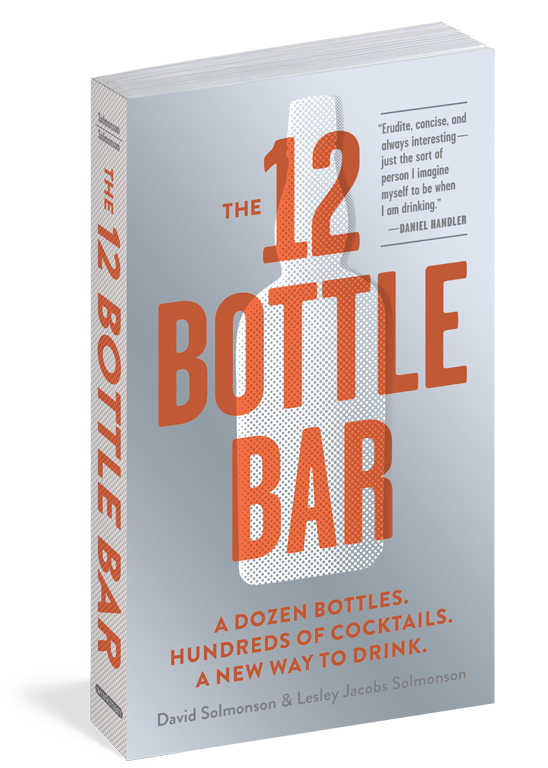 The 12 Bottle Bar begins with one irresistible idea–a complete home bar of just 12 key bottles–and shows you how to make more than 200 classic and unique mixed drinks, including sours, slings, toddies, and highballs, plus the perfect Martini, the perfect Manhattan, and the perfect Mint Julep.
The 12 Bottle Bar begins with one irresistible idea–a complete home bar of just 12 key bottles–and shows you how to make more than 200 classic and unique mixed drinks, including sours, slings, toddies, and highballs, plus the perfect Martini, the perfect Manhattan, and the perfect Mint Julep.
Authors David Solmonson and Lesley Jacobs Solmonson are the husband-and-wife publishers of the popular blog 12bottlebar.com. Follow their exploits as they develop new cocktail recipes.
Get a sneak peek at the book with the Cucumber Gimlet, a perfect drink for end-of-summer entertaining!
GET THE BOOK: Amazon | B&N | ebooks.com | Google Play | iBooks

